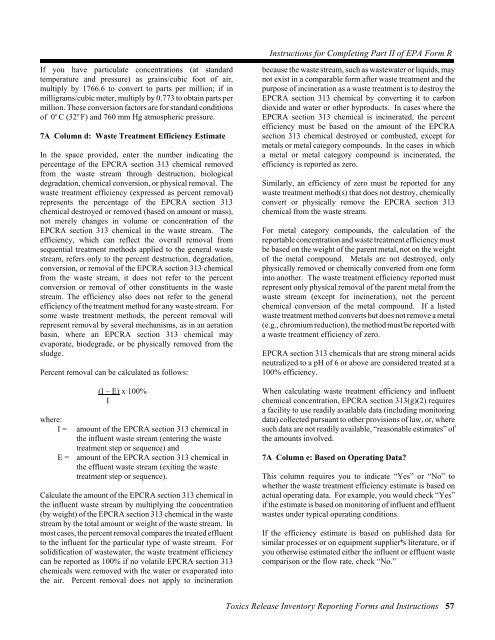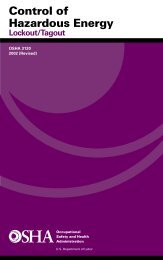Toxic Chemical Release Inventory Reporting Forms and Instructions
Toxic Chemical Release Inventory Reporting Forms and Instructions
Toxic Chemical Release Inventory Reporting Forms and Instructions
You also want an ePaper? Increase the reach of your titles
YUMPU automatically turns print PDFs into web optimized ePapers that Google loves.
<strong>Instructions</strong> for Completing Part II of EPA Form R<br />
If you have particulate concentrations (at st<strong>and</strong>ard<br />
temperature <strong>and</strong> pressure) as grains/cubic foot of air,<br />
multiply by 1766.6 to convert to parts per million; if in<br />
milligrams/cubic meter, multiply by 0.773 to obtain parts per<br />
million. These conversion factors are for st<strong>and</strong>ard conditions<br />
of 0 o C (32 o F) <strong>and</strong> 760 mm Hg atmospheric pressure.<br />
7A Column d: Waste Treatment Efficiency Estimate<br />
In the space provided, enter the number indicating the<br />
percentage of the EPCRA section 313 chemical removed<br />
from the waste stream through destruction, biological<br />
degradation, chemical conversion, or physical removal. The<br />
waste treatment efficiency (expressed as percent removal)<br />
represents the percentage of the EPCRA section 313<br />
chemical destroyed or removed (based on amount or mass),<br />
not merely changes in volume or concentration of the<br />
EPCRA section 313 chemical in the waste stream. The<br />
efficiency, which can reflect the overall removal from<br />
sequential treatment methods applied to the general waste<br />
stream, refers only to the percent destruction, degradation,<br />
conversion, or removal of the EPCRA section 313 chemical<br />
from the waste stream, it does not refer to the percent<br />
conversion or removal of other constituents in the waste<br />
stream. The efficiency also does not refer to the general<br />
efficiency of the treatment method for any waste stream. For<br />
some waste treatment methods, the percent removal will<br />
represent removal by several mechanisms, as in an aeration<br />
basin, where an EPCRA section 313 chemical may<br />
evaporate, biodegrade, or be physically removed from the<br />
sludge.<br />
Percent removal can be calculated as follows:<br />
where:<br />
I =<br />
E =<br />
(I – E) x 100%<br />
I<br />
amount of the EPCRA section 313 chemical in<br />
the influent waste stream (entering the waste<br />
treatment step or sequence) <strong>and</strong><br />
amount of the EPCRA section 313 chemical in<br />
the effluent waste stream (exiting the waste<br />
treatment step or sequence).<br />
Calculate the amount of the EPCRA section 313 chemical in<br />
the influent waste stream by multiplying the concentration<br />
(by weight) of the EPCRA section 313 chemical in the waste<br />
stream by the total amount or weight of the waste stream. In<br />
most cases, the percent removal compares the treated effluent<br />
to the influent for the particular type of waste stream. For<br />
solidification of wastewater, the waste treatment efficiency<br />
can be reported as 100% if no volatile EPCRA section 313<br />
chemicals were removed with the water or evaporated into<br />
the air. Percent removal does not apply to incineration<br />
because the waste stream, such as wastewater or liquids, may<br />
not exist in a comparable form after waste treatment <strong>and</strong> the<br />
purpose of incineration as a waste treatment is to destroy the<br />
EPCRA section 313 chemical by converting it to carbon<br />
dioxide <strong>and</strong> water or other byproducts. In cases where the<br />
EPCRA section 313 chemical is incinerated, the percent<br />
efficiency must be based on the amount of the EPCRA<br />
section 313 chemical destroyed or combusted, except for<br />
metals or metal category compounds. In the cases in which<br />
a metal or metal category compound is incinerated, the<br />
efficiency is reported as zero.<br />
Similarly, an efficiency of zero must be reported for any<br />
waste treatment method(s) that does not destroy, chemically<br />
convert or physically remove the EPCRA section 313<br />
chemical from the waste stream.<br />
For metal category compounds, the calculation of the<br />
reportable concentration <strong>and</strong> waste treatment efficiency must<br />
be based on the weight of the parent metal, not on the weight<br />
of the metal compound. Metals are not destroyed, only<br />
physically removed or chemically converted from one form<br />
into another. The waste treatment efficiency reported must<br />
represent only physical removal of the parent metal from the<br />
waste stream (except for incineration), not the percent<br />
chemical conversion of the metal compound. If a listed<br />
waste treatment method converts but does not remove a metal<br />
(e.g., chromium reduction), the method must be reported with<br />
a waste treatment efficiency of zero.<br />
EPCRA section 313 chemicals that are strong mineral acids<br />
neutralized to a pH of 6 or above are considered treated at a<br />
100% efficiency.<br />
When calculating waste treatment efficiency <strong>and</strong> influent<br />
chemical concentration, EPCRA section 313(g)(2) requires<br />
a facility to use readily available data (including monitoring<br />
data) collected pursuant to other provisions of law, or, where<br />
such data are not readily available, “reasonable estimates” of<br />
the amounts involved.<br />
7A Column e: Based on Operating Data?<br />
This column requires you to indicate “Yes” or “No” to<br />
whether the waste treatment efficiency estimate is based on<br />
actual operating data. For example, you would check “Yes”<br />
if the estimate is based on monitoring of influent <strong>and</strong> effluent<br />
wastes under typical operating conditions.<br />
If the efficiency estimate is based on published data for<br />
similar processes or on equipment supplier*s literature, or if<br />
you otherwise estimated either the influent or effluent waste<br />
comparison or the flow rate, check “No.”<br />
<strong>Toxic</strong>s <strong>Release</strong> <strong>Inventory</strong> <strong>Reporting</strong> <strong>Forms</strong> <strong>and</strong> <strong>Instructions</strong> 57
















